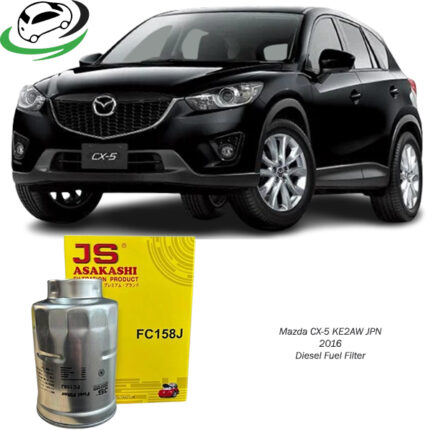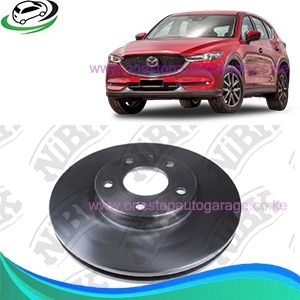-13%
FRONT BRAKE DISC MAZDA CX5 in Kenya
Find the Best Prices for Brake Disc Mazda CX5 in Nairobi Kenya.
The Price for Mazda Cx5 Brake Disc is Ksh 7000 in Nairobi Kenya.
Brake discs, also known as brake rotors, are crucial components in a vehicle’s braking system. They play a pivotal role in slowing down and stopping the vehicle safely. Understanding the functions of brake discs and recognizing signs of wear is essential for maintaining optimal braking performance and ensuring the safety of the vehicle and its occupants.
Functions of Brake Discs:
1. Heat Dissipation:
- Brake discs dissipate heat generated during the braking process. When the brake pads clamp onto the spinning disc, kinetic energy is converted into heat. Efficient heat dissipation prevents overheating and maintains the effectiveness of the braking system.
2. Friction Surface:
- The brake disc provides a friction surface for the brake pads. When the brake pedal is pressed, hydraulic pressure forces the brake pads against the rotating disc, creating the necessary friction to slow down or stop the vehicle.
3. Smooth and Consistent Braking:
- Brake discs contribute to smooth and consistent braking performance. Their flat, smooth surfaces allow for even contact with the brake pads, ensuring a predictable and controlled braking experience.
4. Weight Distribution:
- The weight distribution of a vehicle is crucial for effective braking. Brake discs, positioned at the wheel hubs, aid in distributing braking forces evenly across the vehicle, promoting stability and preventing wheel lock-up.
5. Durability:
- Brake discs are engineered to withstand substantial forces and high temperatures. They are typically made from materials such as cast iron or composite materials that offer durability and heat resistance.
Signs of Worn Out Brake Discs:
1. Scoring or Grooving:
- Visible scoring or grooving on the surface of the brake disc is a clear sign of wear. As the brake pads make contact with the disc, friction can wear down the surface over time. Excessive scoring can compromise braking efficiency and lead to longer stopping distances.
2. Vibration or Pulsation:
- A noticeable vibration or pulsation felt through the brake pedal during braking is often indicative of uneven wear on the brake discs. This can result from irregularities in the disc surface, causing an inconsistent grip between the brake pads and the disc.
3. Squealing or Squeaking Noises:
- High-pitched squealing or squeaking noises during braking may suggest worn brake discs. This can occur when the brake pads come into contact with an uneven or worn disc surface, producing audible friction.
4. Deep Rust or Corrosion:
- Deep rust or corrosion on the brake disc surfaces can affect their performance. Rust can form when a vehicle is parked for an extended period or if it’s exposed to harsh environmental conditions. Surface rust is normal, but excessive corrosion may compromise the structural integrity of the disc.
5. Reduced Thickness:
- Brake discs have a minimum allowable thickness. Over time, as the disc wears down, it may approach or fall below this minimum thickness. Reduced disc thickness compromises heat dissipation and structural integrity, leading to diminished braking performance.
6. Visible Cracks:
- Inspect the brake discs for visible cracks. Cracks can develop due to thermal stress, age, or manufacturing defects. Cracked discs are a serious safety concern and should be replaced immediately to prevent catastrophic failure.
7. Blue or Discolored Appearance:
- Excessive heat can cause the brake discs to turn blue or exhibit a discolored appearance. This indicates overheating and can lead to a phenomenon known as brake fade, where the braking efficiency diminishes due to the reduced friction coefficient of the overheated disc.
8. Extended Stopping Distances:
- If you notice a significant increase in stopping distances, it may be a sign that the brake discs are worn. Reduced thickness or uneven wear can compromise the braking system’s ability to generate sufficient friction, resulting in longer stopping distances.
9. Dashboard Warning Light:
- Some modern vehicles are equipped with brake wear sensors that trigger a dashboard warning light when the brake discs or pads are worn beyond the recommended limits. If this warning light illuminates, it’s crucial to have the braking system inspected promptly.
In conclusion, brake discs are integral to the safety and performance of a vehicle’s braking system. Regular inspections and prompt attention to signs of wear are essential for maintaining effective braking capabilities. If any of the mentioned signs are observed, it is advisable to consult with a qualified mechanic to assess the condition of the brake discs and, if necessary, replace them to ensure the continued safety and reliability of the vehicle. Brake maintenance is a critical aspect of vehicle ownership, and proactive measures can prevent more severe issues and potential safety hazards on the road.



